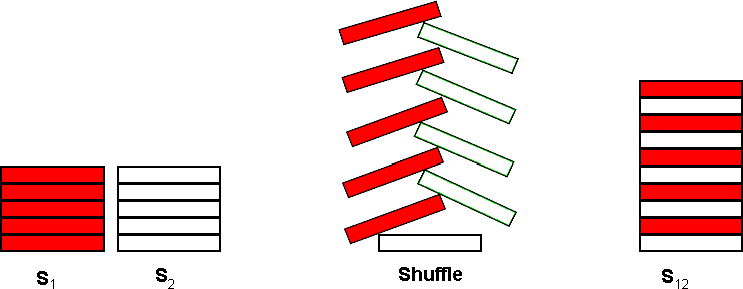[暴力搜索] POJ 3087 Shuffle'm Up
| Time Limit: 1000MS | Memory Limit: 65536K | |
| Total Submissions: 10003 | Accepted: 4631 |
Description
A common pastime for poker players at a poker table is to shuffle stacks of chips. Shuffling chips is performed by starting with two stacks of poker chips, S1 and S2, each stack containing C chips. Each stack may contain chips of several different colors.
The actual shuffle operation is performed by interleaving a chip from S1 with a chip from S2 as shown below for C = 5:

The single resultant stack, S12, contains 2 * C chips. The bottommost chip of S12 is the bottommost chip from S2. On top of that chip, is the bottommost chip from S1. The interleaving process continues taking the 2nd chip from the bottom of S2 and placing that on S12, followed by the 2nd chip from the bottom of S1 and so on until the topmost chip from S1 is placed on top of S12.
After the shuffle operation, S12 is split into 2 new stacks by taking the bottommost C chips from S12 to form a new S1 and the topmost C chips from S12 to form a new S2. The shuffle operation may then be repeated to form a new S12.
For this problem, you will write a program to determine if a particular resultant stack S12 can be formed by shuffling two stacks some number of times.
Input
The first line of input contains a single integer N, (1 ≤ N ≤ 1000) which is the number of datasets that follow.
Each dataset consists of four lines of input. The first line of a dataset specifies an integer C, (1 ≤ C ≤ 100) which is the number of chips in each initial stack (S1 and S2). The second line of each dataset specifies the colors of each of the C chips in stack S1, starting with the bottommost chip. The third line of each dataset specifies the colors of each of the C chips in stack S2 starting with the bottommost chip. Colors are expressed as a single uppercase letter (A through H). There are no blanks or separators between the chip colors. The fourth line of each dataset contains 2 * C uppercase letters (A through H), representing the colors of the desired result of the shuffling of S1 and S2 zero or more times. The bottommost chip’s color is specified first.
Output
Output for each dataset consists of a single line that displays the dataset number (1 though N), a space, and an integer value which is the minimum number of shuffle operations required to get the desired resultant stack. If the desired result can not be reached using the input for the dataset, display the value negative 1 (−1) for the number of shuffle operations.
Sample Input
- 2
- 4
- AHAH
- HAHA
- HHAAAAHH
- 3
- CDE
- CDE
- EEDDCC
Sample Output
- 1 2
- 2 -1
Source
- #include<stdio.h>
- #include<string.h>
- int main()
- {
- int T,n,times,i,j,cnt,flag;
- char s1[210],s2[210],s12[210],aim[210],temp[210];
- scanf("%d",&T);
- for(j=1;j<=T;++j)
- {
- cnt=flag=0;times=1;
- scanf("%d%s%s%s",&n,s1,s2,aim);
- for(i=0;i<strlen(s2);++i) s12[i*2]=s2[i];
- for(i=0;i<strlen(s1);++i) s12[i*2+1]=s1[i];
- s12[2*n]='\0';strcpy(temp,s12);
- while(strcmp(s12,aim)!=0)
- {
- strncpy(s1,s12,n);strncpy(s2,s12+n,n);
- for(i=0;i<strlen(s2);++i) s12[i*2]=s2[i];
- for(i=0;i<strlen(s1);++i) s12[i*2+1]=s1[i];
- s12[2*n]='\0';
- if(!strcmp(temp,s12))
- {
- flag=1;
- break;
- }
- ++times;
- }
- if(!flag) printf("%d %d\n",j,times); else printf("%d -1\n",j);
- }
- return 0;
- }
[暴力搜索] POJ 3087 Shuffle'm Up的更多相关文章
- POJ 3087 Shuffle'm Up(洗牌)
POJ 3087 Shuffle'm Up(洗牌) Time Limit: 1000MS Memory Limit: 65536K Description - 题目描述 A common pas ...
- DFS POJ 3087 Shuffle'm Up
题目传送门 /* 题意:两块扑克牌按照顺序叠起来后,把下半部分给第一块,上半部给第二块,一直持续下去,直到叠成指定的样子 DFS:直接模拟搜索,用map记录该字符串是否被搜过.读懂题目是关键. */ ...
- POJ.3087 Shuffle'm Up (模拟)
POJ.3087 Shuffle'm Up (模拟) 题意分析 给定两个长度为len的字符串s1和s2, 接着给出一个长度为len*2的字符串s12. 将字符串s1和s2通过一定的变换变成s12,找到 ...
- POJ 3087 Shuffle'm Up
Shuffle'm Up Time Limit:1000MS Memory Limit:65536KB 64bit IO Format:%I64d & %I64u Submit ...
- POJ 3087 Shuffle'm Up 线性同余,暴力 难度:2
http://poj.org/problem?id=3087 设:s1={A1,A2,A3,...Ac} s2={Ac+1,Ac+2,Ac+3,....A2c} 则 合在一起成为 Ac+1,A1,Ac ...
- POJ 3087 Shuffle'm Up 模拟,看着不像搜索啊
题意:给定s1,s1两副扑克,顺序从下到上.依次将s2,s1的扑克一张一张混合.例如s1,ABC; s2,DEF. 则第一次混合后为DAEBFC. 然后令前半段为s1, 后半段为s2. 如果可以变换成 ...
- poj 3087 Shuffle'm Up ( map 模拟 )
题目:http://poj.org/problem?id=3087 题意:已知两堆牌s1和s2的初始状态, 其牌数均为c,按给定规则能将他们相互交叉组合成一堆牌s12,再将s12的最底下的c块牌归为s ...
- POJ 3087 Shuffle'm Up (模拟+map)
题目链接:http://poj.org/problem?id=3087 题目大意:已知两堆牌s1和s2的初始状态, 其牌数均为c,按给定规则能将他们相互交叉组合成一堆牌s12,再将s12的最底下的c块 ...
- POJ 3087 Shuffle'm Up DFS
link:http://poj.org/problem?id=3087 题意:给你两串字串(必定偶数长),按照扑克牌那样的洗法(每次从S2堆底中拿第一张,再从S1堆底拿一张放在上面),洗好后的一堆可以 ...
随机推荐
- 【前端】从输入URL到页面加载完成的过程中都发生了什么事情
把URL分割成几个部分:协议(http, https).网络地址(xxx.xxx.xxx.xxx).资源路径(/xxx/xxx.xx).端口号(默认80). 如果地址不是一个IP地址,通过DNS(域名 ...
- CSS篇
一.盒子模型: 标准模式和混杂模式(IE).在标准模式下浏览器按照规范呈现页面:在混杂模式下,页面以一种比较宽松的向后兼容的方式显示.混杂模式通常模拟老式浏览器的行为以防止老站点无法工作. CSS盒子 ...
- 关于 OJ1574的参考题解(较麻烦)
#include <stdio.h>int main(){ long a,b,c,d,e; scanf("%ld",&a); d=a; b=0; while(d ...
- ImageList图标左边有黑色竖线
ImageList图标左边有黑色竖线, 原因 ImageList颜色深度太小引起的,解决方案,把颜色深度调成Depth32Bit 默认: 修改为: 结果: 备注:根据文件获得文件的系统图标: Icon ...
- 2014鸟人Birdman中文字幕文件下载
下载后,解压缩,会得到 Birdman.2014.1080p.WEB-DL.DD5.1.H264-RARBG.srt 文件,把这个文件放到视频文件(mkv文件)相同的文件夹里. 用暴风影音播放,如果没 ...
- 语言模拟ATM自动取款机系统
C语言实验报告 题目名称:C语言模拟ATM自动取款机系统 C语言模拟实现ATM自动取款机功能:输入密码,余额查询,取款,存款,转账,修改密码,退出功能: 代码实现的功能: 账号及密码输入: ...
- Cocos2d-x 核心概念 - 坐标系(UI.OpenGL.世界坐标系.模型坐标系)
UI坐标系与OpenGL坐标系 UI坐标就是Android和IOS等应用开发时候使用的二维坐标系,原点在左上角 OpenGL坐标是三维坐标,由于Cocos2d-x Lua 底层采用OpenGL渲染,因 ...
- 【所见即所得】textarea 精确限制字数、行数,中、英、全半角混检 。源码带注释
主要解决难点: 1 中文 全角2字符深深的恶意 2 多行输入textarea 手动,自动换行问题 3 获得每行内容 原创,转载请注明出处! <!DOCTYPE html PUBLIC " ...
- 获取Echarts的DataZoom的起始值
创建DataZoom拖动事件 myChart.on(ecConfig.EVENT.DATA_ZOOM, eConsole); //事件名, 相关联的方法名 var ecConfig = requi ...
- MongoDB 概念解析
SQL术语/概念 MongoDB术语/概念 解释/说明 database database 数据库 table collection 数据库表/集合 row document 数据记录行/文档 col ...
